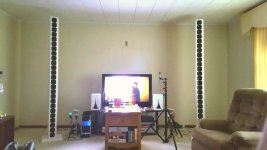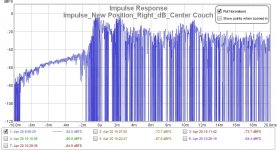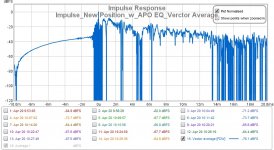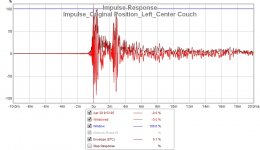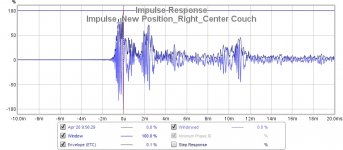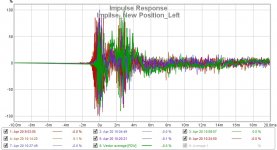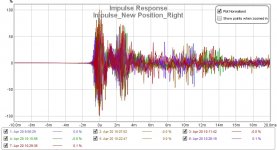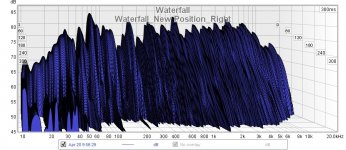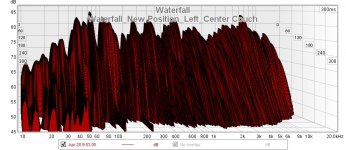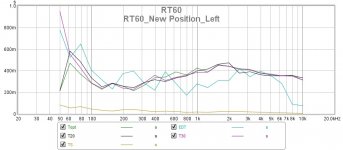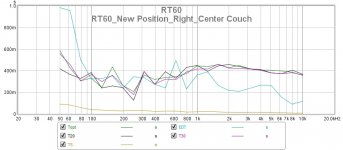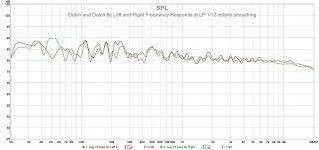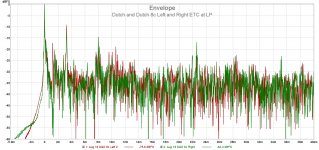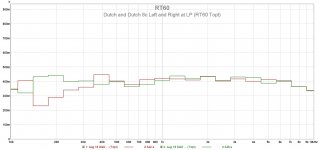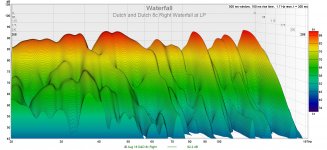I've read a lot about room treatment but am not sure how to apply it to my newly built line arrays. From what I understand, line arrays should be easier to manage in a small 15x18' room.
I know that I need to control my first reflections. What about bass traps? I have heard that low bass is the first thing that needs to be addressed. Everyone that I see building an array wants to put them in a corner to increase bass but I am finding less midrange clarity and excess boominess from the bass. Do I need bass traps?
I know that I need to control my first reflections. What about bass traps? I have heard that low bass is the first thing that needs to be addressed. Everyone that I see building an array wants to put them in a corner to increase bass but I am finding less midrange clarity and excess boominess from the bass. Do I need bass traps?
I would not put them in a corner unless you can hit them with significant Digital Signal Processing. It works for Wesayo in the corners because he's running a lot of things in Jriver to process the signal before the arrays. Sometimes it will just work, but very unlikely.
"Do I need bass traps" is a very "it depends" kind of question. Some people are happy with a little EQ on their speakers and then their room is good enough for them. Most rooms will benefit from treatment but benefiting doesn't mean necessary.
Always start with "What about the sound don't I like" and target that. With lower midrange clarity and excess boominess then yeah, bass traps will most likely help.
Measuring with a decent mic and software can also help point you where you need to go, help you target and nail down what you're hearing and need to do.
"Do I need bass traps" is a very "it depends" kind of question. Some people are happy with a little EQ on their speakers and then their room is good enough for them. Most rooms will benefit from treatment but benefiting doesn't mean necessary.
Always start with "What about the sound don't I like" and target that. With lower midrange clarity and excess boominess then yeah, bass traps will most likely help.
Measuring with a decent mic and software can also help point you where you need to go, help you target and nail down what you're hearing and need to do.
A miniDSP with Dirac has been part of my plan from the beginning of this build but I haven't bought it yet because it didn't fit in this month's budget. Yes, eq is mandatory.
When I put the arrays in the corners the bass was the right volume but was boomy and the mid-bass didn't sound as clear. Some recommend corner placement and others don't.
A few questions:
At what point do room modes cause issues that can't be corrected by dsp/eq?
My current speaker position is barely affecting the room modes compared to the corners. I'm afraid that I may overstrain my amp (125wps) if I put it in a null and try to EQ it.
Can the perceived lack of clarity be corrected by dsp/eq?
To get the best end sound, how would you prioritize this list:
Position speakers
Room Treatment
Eq speakers flat
Room correction dsp
When I put the arrays in the corners the bass was the right volume but was boomy and the mid-bass didn't sound as clear. Some recommend corner placement and others don't.
A few questions:
At what point do room modes cause issues that can't be corrected by dsp/eq?
My current speaker position is barely affecting the room modes compared to the corners. I'm afraid that I may overstrain my amp (125wps) if I put it in a null and try to EQ it.
Can the perceived lack of clarity be corrected by dsp/eq?
To get the best end sound, how would you prioritize this list:
Position speakers
Room Treatment
Eq speakers flat
Room correction dsp
You pretty much have it in the order I'd put it personally.
Adding a subwoofer or two distributed around the room will definitely help get the bass you want, and multiple subs can help you attack the room modes.
One thing with EQ, never boost nulls, if you do that you'll be safe, only ever cut peaks. Of course this isn't 100% absolute, but it's a pretty good general rule. The deeper the null the less you should try to EQ it and attack it with a different method.
The perceived lack of clarity can definitely be helped by EQ. If you don't have any now than who knows what's going on. Midbass could be recessed while lower end and high end rise. The dreaded "smile curve".
At what point do room modes cause issues that can't be corrected by dsp/eq? Right from the start. But you might be fine between placement and room size and such. Whether the room modes are noticeable to you is the important bit.
Adding a subwoofer or two distributed around the room will definitely help get the bass you want, and multiple subs can help you attack the room modes.
One thing with EQ, never boost nulls, if you do that you'll be safe, only ever cut peaks. Of course this isn't 100% absolute, but it's a pretty good general rule. The deeper the null the less you should try to EQ it and attack it with a different method.
The perceived lack of clarity can definitely be helped by EQ. If you don't have any now than who knows what's going on. Midbass could be recessed while lower end and high end rise. The dreaded "smile curve".
At what point do room modes cause issues that can't be corrected by dsp/eq? Right from the start. But you might be fine between placement and room size and such. Whether the room modes are noticeable to you is the important bit.
It is good that you are questioning this.Can the perceived lack of clarity be corrected by dsp/eq?
I really like the simplistic concept Roger Russell created with the IDS-25 and being able to have all the bass come from the arrays with no subwoofers. I also want to get the clearest possible sound from that setup.
I know that my amp may be the weak link in the long run. I feel that the arrays have enough headroom to do what what Roger Russell intended if I had the right amp. I could definitely get the bass I am looking for of i put them in the corners, but I felt that they sounded a little off.
Light room treatment will definitely make these arrays sing. To try the concept I put couch pillows along the back of the couch behind my head. Huge difference and the music is really coming alive.
...i listen to music relatively quietly around 70db. That is why I think I can get by without subwoofers ... and I don't want the extra expense.
I know that my amp may be the weak link in the long run. I feel that the arrays have enough headroom to do what what Roger Russell intended if I had the right amp. I could definitely get the bass I am looking for of i put them in the corners, but I felt that they sounded a little off.
Light room treatment will definitely make these arrays sing. To try the concept I put couch pillows along the back of the couch behind my head. Huge difference and the music is really coming alive.
...i listen to music relatively quietly around 70db. That is why I think I can get by without subwoofers ... and I don't want the extra expense.
Have you used REW/mic at the listening position to measure the rooms reflections (i.e. ETC display), low frequency decay (i.e. waterfall display) and RT60 values?
Rule of thumb for the ETC display is to have early reflections -10 to -20 dB lower than the main spike for the first 20 to 40ms of sound arrival.
The waterfall display will let you know if there are any low frequency ringing/reflections room modes. This will help determine if bass traps can help (i.e. below 100 Hz bass traps do very little).
The RT60 display will show you how smooth the decay time is over a wide frequency range and can help determine if you need any broad band absorbers and/or diffusers. For a room your size, a smooth RT60 of 200ms to 400ms is likely an acceptable range (you need to work out the range from the specs below as it based on size of room).
Personally, I would eq the system first for the frequency response voicing you prefer and with the eq filter in the signal path, remeasure with REW and check the graphs as described above. Without any eq, you could get false readings where for example the RT60 is high in the midrange, but it is due to the speakers having a midrange peak in the fr, but is fine after eq, as one example.
There are some industry guidelines that can help guide you if interested Something like https://www.itu.int/dms_pubrec/itu-r/rec/bs/R-REC-BS.1116-3-201502-I!!PDF-E.pdf and https://tech.ebu.ch/docs/tech/tech3276.pdf as examples. Most of these spec are still valid today, except for target frequency response, which should be updated with the R&D that Toole and Olive have developed: NAD VISO HP50 with Roomfeel Headphone Review - Reviews - Audiophile Style
I followed this approach and ended up with a handful of broad band absorbers to smooth out the midrange reverb time and put an area rug (with two layers of underlay) between the couch and speakers to also bring down the overall reverb time in my room to fall within spec as I have a lively room.
Good luck and enjoy the music!
Rule of thumb for the ETC display is to have early reflections -10 to -20 dB lower than the main spike for the first 20 to 40ms of sound arrival.
The waterfall display will let you know if there are any low frequency ringing/reflections room modes. This will help determine if bass traps can help (i.e. below 100 Hz bass traps do very little).
The RT60 display will show you how smooth the decay time is over a wide frequency range and can help determine if you need any broad band absorbers and/or diffusers. For a room your size, a smooth RT60 of 200ms to 400ms is likely an acceptable range (you need to work out the range from the specs below as it based on size of room).
Personally, I would eq the system first for the frequency response voicing you prefer and with the eq filter in the signal path, remeasure with REW and check the graphs as described above. Without any eq, you could get false readings where for example the RT60 is high in the midrange, but it is due to the speakers having a midrange peak in the fr, but is fine after eq, as one example.
There are some industry guidelines that can help guide you if interested Something like https://www.itu.int/dms_pubrec/itu-r/rec/bs/R-REC-BS.1116-3-201502-I!!PDF-E.pdf and https://tech.ebu.ch/docs/tech/tech3276.pdf as examples. Most of these spec are still valid today, except for target frequency response, which should be updated with the R&D that Toole and Olive have developed: NAD VISO HP50 with Roomfeel Headphone Review - Reviews - Audiophile Style
I followed this approach and ended up with a handful of broad band absorbers to smooth out the midrange reverb time and put an area rug (with two layers of underlay) between the couch and speakers to also bring down the overall reverb time in my room to fall within spec as I have a lively room.
Good luck and enjoy the music!
% Impulse:
Center of couch left
Center of couch right
All left measurements
All right measurements
Center of couch left
Center of couch right
All left measurements
All right measurements
Attachments
Unfortunately RT60 isn't valid for small rooms, which your's probably falls into. You want ETC curve instead.
I don't see a straight frequency response, but judging from the waterfalls you have a large dip from 100 to about 300 Hz and then another to about 600 Hz. Those are why your midbass vs bass is a little wonky. Looking at your room size, those are definitely room modes I'd say. 3'rd, 4'th, and 5'th multiples of the primary modes. You can tell because of the spike in decay time on the waterfall right at 110 Hz and 220Hz or so with the major recession of decay in between.
Room treatment would help, with bass traps in the corners. Small subs around the room might help break up the modes, but with the long decay you have I'd look at those as second option or in conjunction with traps. Eq won't do too much there as most of that is a null, not major peaks.
I don't see a straight frequency response, but judging from the waterfalls you have a large dip from 100 to about 300 Hz and then another to about 600 Hz. Those are why your midbass vs bass is a little wonky. Looking at your room size, those are definitely room modes I'd say. 3'rd, 4'th, and 5'th multiples of the primary modes. You can tell because of the spike in decay time on the waterfall right at 110 Hz and 220Hz or so with the major recession of decay in between.
Room treatment would help, with bass traps in the corners. Small subs around the room might help break up the modes, but with the long decay you have I'd look at those as second option or in conjunction with traps. Eq won't do too much there as most of that is a null, not major peaks.
"...RT60 is typically not meaningful in such rooms below a few hundred Hz. Use the waterfall, spectrogram and decay plots to examine the decay of low frequencies in domestically-sized rooms." RT60 Graph @mushroommunk agreed, but with the caveat mentioned. It is still a useful metric above a few hundred hertz to get an idea of the midrange and high frequency decay in one's room. Discussing with JohnM, the author of REW, suggest that Topt is the most useful derivation of RT60 for small rooms down to 100 Hz.
@Nvphotos I can't make heads or tails from you graphs as they are not using the recommended vertical and horizontal scales. For example, I tested out Dutch and Dutch 8c's and here is the frequency response using REW's recommended vertical and horizontal scales. Also note, I am using REW's "Overlays" capabilities:

ETC graph covering 60 dB of vertical scale and the first 40ms of sound travel, again using REW's Overlays feature:
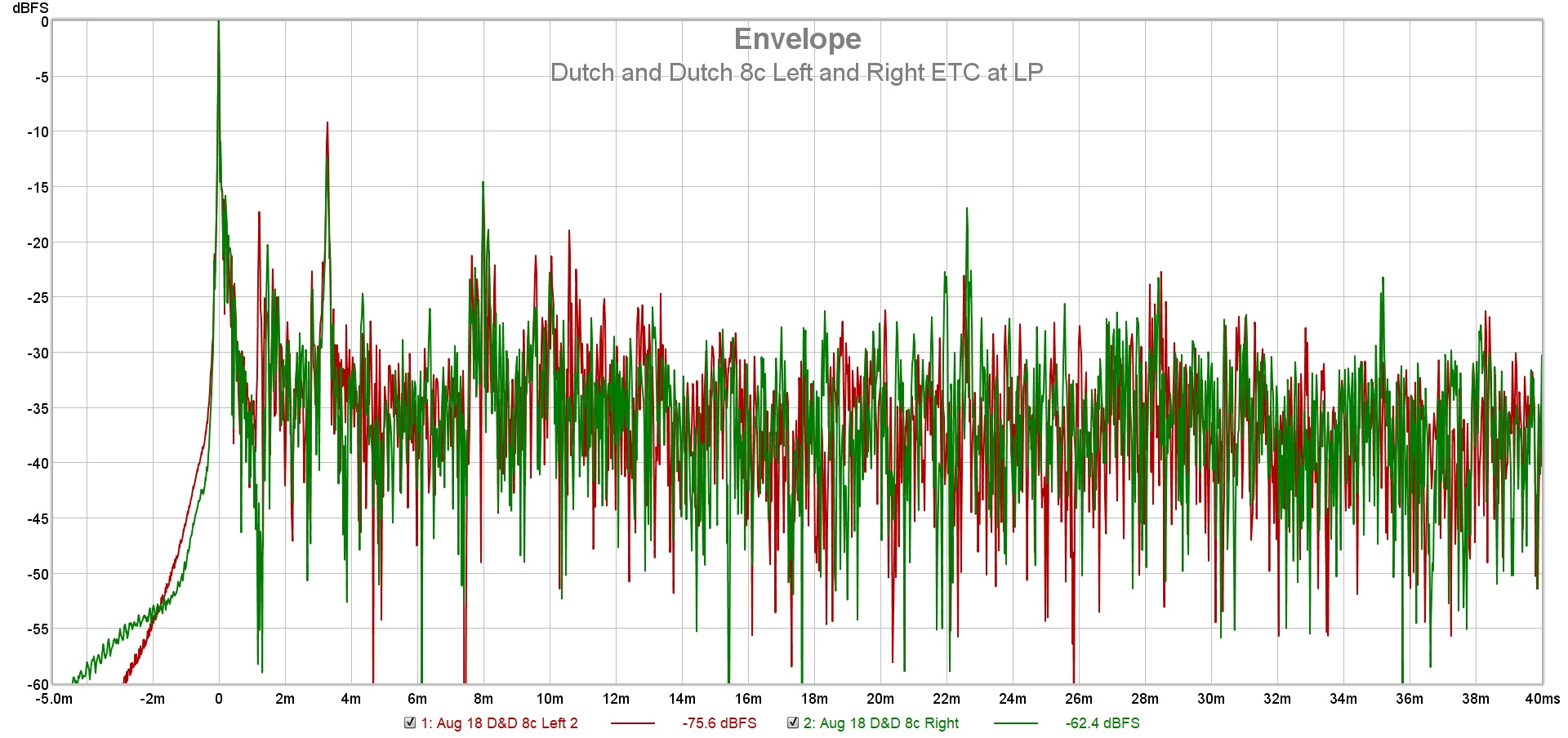
I have a pretty good reflection off the front wall and arriving at the mic just over 3ms from the direct sound. That's from the rear firing woofers on the 8c. But otherwise, most spikes are -15 dB down or better.
RT60 or using the correct overlay shows Topt from 100Hz to 10 kHz:
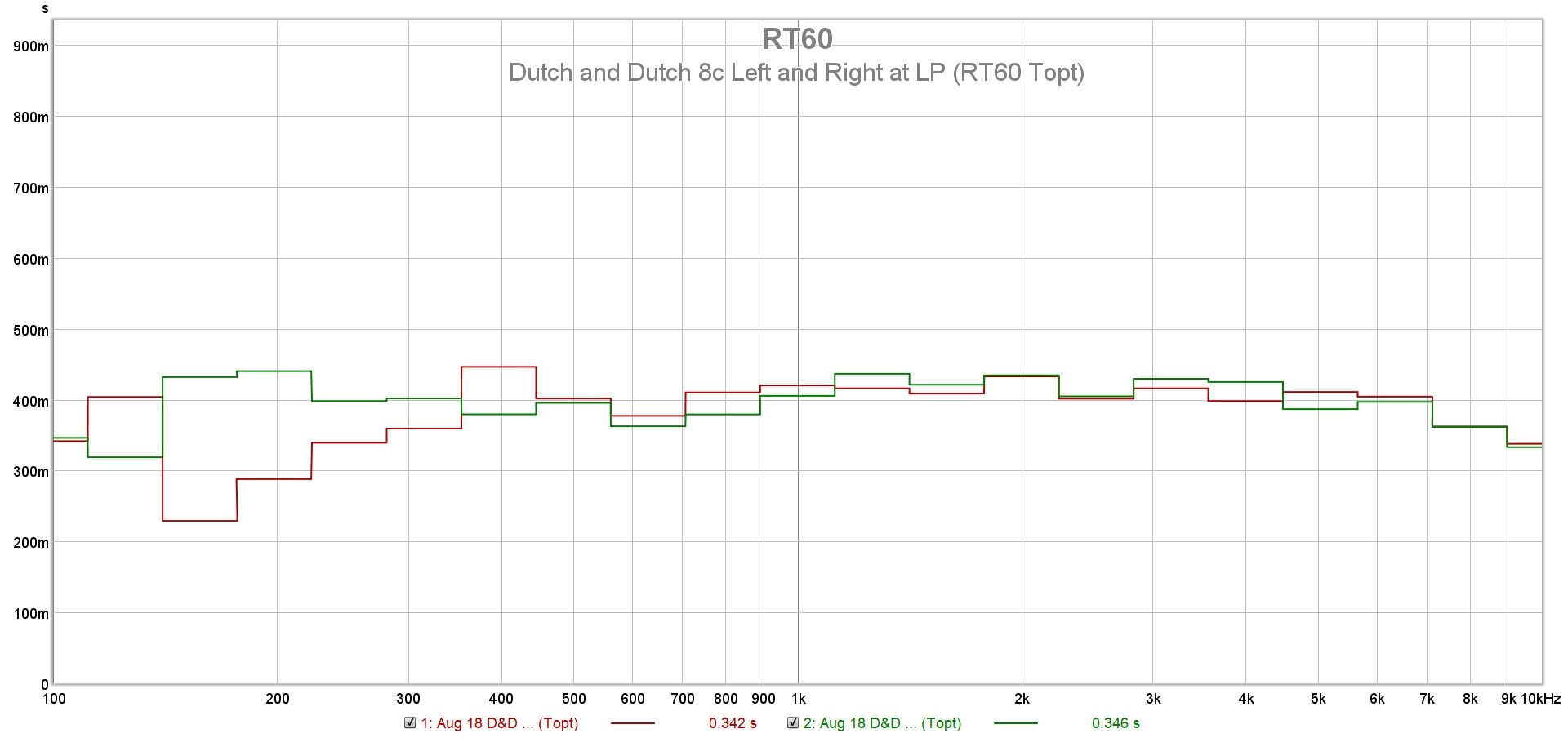
I am at the top end of the recommended decay time for my size room at 400ms based on the specs I linked to in my other post. But with some use of wideband panel absorbers and heavy velour curtains, smooths out the decay time across the frequency range, is what we are shooting for.
Finally, a waterfall of the right speaker showing low frequency decay. Note the horizontal and vertical scales again - this is the default view from REW:
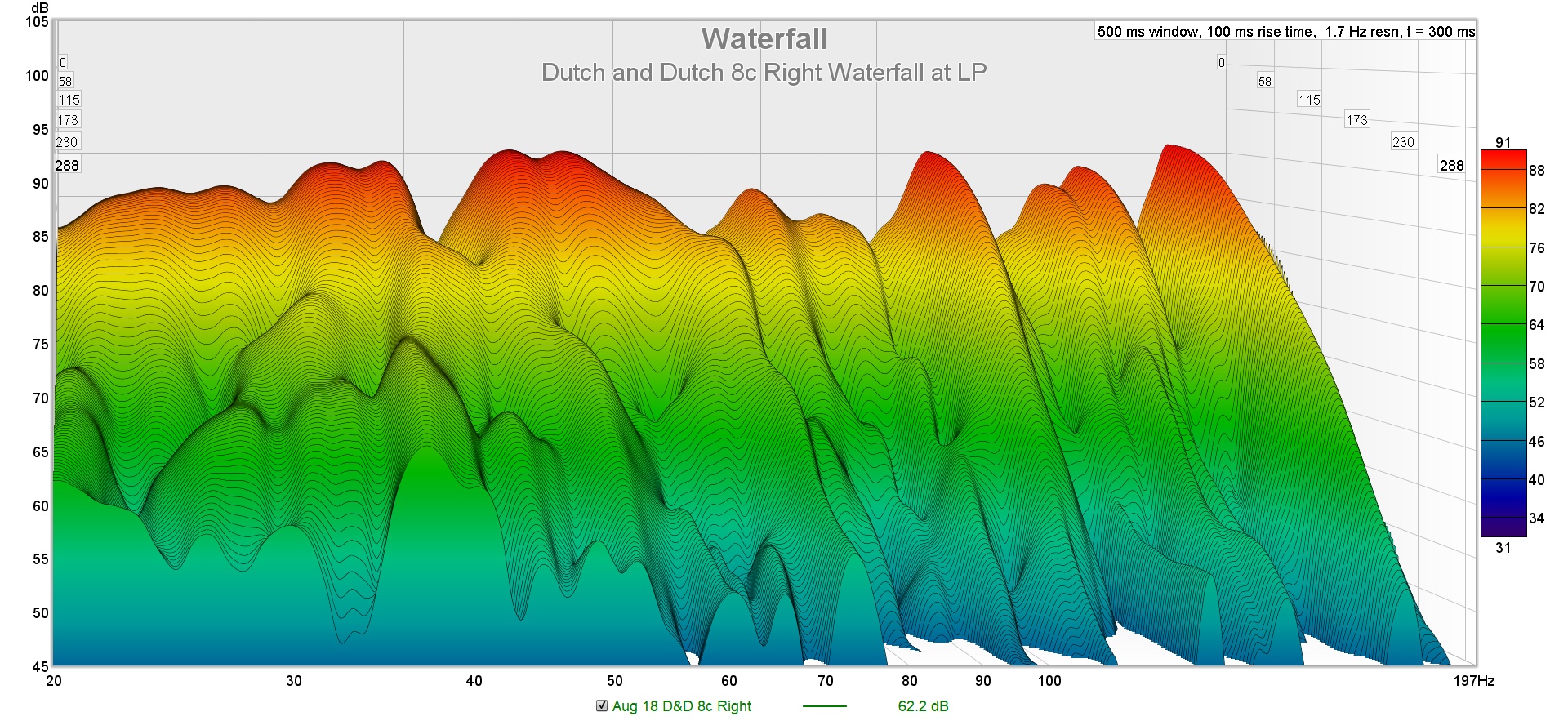
A few room modes and some low frequency build up, but not enough to warrant bass traps. As a former designer and manufacturer of acoustic treatment products, you need a lot of bass traps (like stuffing the room) to do anything effective below 100 Hz.
@Nvphotos, hope some of that is helpful and at least being able to use the overlays feature in REW and setup the vertical and horizontal scales to see the areas of interest.
Enjoy the music!
@Nvphotos I can't make heads or tails from you graphs as they are not using the recommended vertical and horizontal scales. For example, I tested out Dutch and Dutch 8c's and here is the frequency response using REW's recommended vertical and horizontal scales. Also note, I am using REW's "Overlays" capabilities:
ETC graph covering 60 dB of vertical scale and the first 40ms of sound travel, again using REW's Overlays feature:
I have a pretty good reflection off the front wall and arriving at the mic just over 3ms from the direct sound. That's from the rear firing woofers on the 8c. But otherwise, most spikes are -15 dB down or better.
RT60 or using the correct overlay shows Topt from 100Hz to 10 kHz:
I am at the top end of the recommended decay time for my size room at 400ms based on the specs I linked to in my other post. But with some use of wideband panel absorbers and heavy velour curtains, smooths out the decay time across the frequency range, is what we are shooting for.
Finally, a waterfall of the right speaker showing low frequency decay. Note the horizontal and vertical scales again - this is the default view from REW:
A few room modes and some low frequency build up, but not enough to warrant bass traps. As a former designer and manufacturer of acoustic treatment products, you need a lot of bass traps (like stuffing the room) to do anything effective below 100 Hz.
@Nvphotos, hope some of that is helpful and at least being able to use the overlays feature in REW and setup the vertical and horizontal scales to see the areas of interest.
Enjoy the music!
Attachments
- Status
- This old topic is closed. If you want to reopen this topic, contact a moderator using the "Report Post" button.
- Home
- General Interest
- Room Acoustics & Mods
- Room Treatment for Line Arrays
